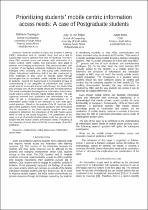 ResearchSpace
ResearchSpace
Prioritizing students’ mobile centric information access needs: A case of postgraduate students
JavaScript is disabled for your browser. Some features of this site may not work without it.
- ResearchSpace
- →
- Research Publications/Outputs
- →
- Conference Publications
- →
- View Item
| dc.contributor.author |
Chipangura, B

|
|
| dc.contributor.author |
Van Biljon, JA

|
|
| dc.contributor.author |
Botha, Adèle

|
|
| dc.date.accessioned | 2014-10-24T13:20:21Z | |
| dc.date.available | 2014-10-24T13:20:21Z | |
| dc.date.issued | 2013-11 | |
| dc.identifier.citation | Chipangura, B, Van Biljon, J.A and Botha, A. 2013. Prioritizing students’ mobile centric information access needs: A case of postgraduate students. In: ICAST 2013, CSIR-Pretoria, South Africa, 25-27 November 2013 | en_US |
| dc.identifier.uri | http://ieeexplore.ieee.org/stamp/stamp.jsp?arnumber=6707519 | |
| dc.identifier.uri | http://hdl.handle.net/10204/7731 | |
| dc.description | ICAST 2013, CSIR-Pretoria, South Africa, 25-27 November 2013 | en_US |
| dc.description.abstract | Students enrolled at Open and Distance Learning (ODL) institutions tend to combine study and work and to succeed they have to optimize free time for studying. Therefore, many ODL students access and interact with information in a mobile context, which implies that interaction takes place in dynamic and changing environments. This presents students with a number of overlapping contextual challenges that need to be managed when accessing and interacting with information. Higher Educational Institutions (HEIs) are also confronted by these challenges as they strive to provide access through technologies that are accessible, usable, scalable and sustainable to students. Against this background, it is important to have an understanding of the categories of information that students would want to access and interact with through the devices that they privately own, of which mobile phones are the most common. This study investigated the categories of information that students would want to access through mobile cellular phones. The data capturing involved both qualitative and quantitative data. In order to get a comprehensive and representative set of information access needs it was necessary to start with open-ended questions. Based on the analysis of the 50 responses to the open-ended questions, fixed-response questions were formulated. The 84 responses to the fixed-response questions were then analyzed to determine the importance of the information access needs as well as the access frequency. The contribution of this paper is a set of prioritized information needs that provide some insight into the mobile centric information needs of students at the University of South Africa (UNISA) as an example of an ODL institution. | en_US |
| dc.language.iso | en | en_US |
| dc.publisher | IEEE Xplore | en_US |
| dc.relation.ispartofseries | Workflow;11893 | |
| dc.subject | Open and Distance Learning | en_US |
| dc.subject | ODL | en_US |
| dc.subject | Mobile contextual information | en_US |
| dc.subject | Mobile access | en_US |
| dc.title | Prioritizing students’ mobile centric information access needs: A case of postgraduate students | en_US |
| dc.type | Conference Presentation | en_US |
| dc.identifier.apacitation | Chipangura, B., Van Biljon, J., & Botha, A. (2013). Prioritizing students’ mobile centric information access needs: A case of postgraduate students. IEEE Xplore. http://hdl.handle.net/10204/7731 | en_ZA |
| dc.identifier.chicagocitation | Chipangura, B, JA Van Biljon, and Adèle Botha. "Prioritizing students’ mobile centric information access needs: A case of postgraduate students." (2013): http://hdl.handle.net/10204/7731 | en_ZA |
| dc.identifier.vancouvercitation | Chipangura B, Van Biljon J, Botha A, Prioritizing students’ mobile centric information access needs: A case of postgraduate students; IEEE Xplore; 2013. http://hdl.handle.net/10204/7731 . | en_ZA |
| dc.identifier.ris | TY - Conference Presentation AU - Chipangura, B AU - Van Biljon, JA AU - Botha, Adèle AB - Students enrolled at Open and Distance Learning (ODL) institutions tend to combine study and work and to succeed they have to optimize free time for studying. Therefore, many ODL students access and interact with information in a mobile context, which implies that interaction takes place in dynamic and changing environments. This presents students with a number of overlapping contextual challenges that need to be managed when accessing and interacting with information. Higher Educational Institutions (HEIs) are also confronted by these challenges as they strive to provide access through technologies that are accessible, usable, scalable and sustainable to students. Against this background, it is important to have an understanding of the categories of information that students would want to access and interact with through the devices that they privately own, of which mobile phones are the most common. This study investigated the categories of information that students would want to access through mobile cellular phones. The data capturing involved both qualitative and quantitative data. In order to get a comprehensive and representative set of information access needs it was necessary to start with open-ended questions. Based on the analysis of the 50 responses to the open-ended questions, fixed-response questions were formulated. The 84 responses to the fixed-response questions were then analyzed to determine the importance of the information access needs as well as the access frequency. The contribution of this paper is a set of prioritized information needs that provide some insight into the mobile centric information needs of students at the University of South Africa (UNISA) as an example of an ODL institution. DA - 2013-11 DB - ResearchSpace DP - CSIR KW - Open and Distance Learning KW - ODL KW - Mobile contextual information KW - Mobile access LK - https://researchspace.csir.co.za PY - 2013 T1 - Prioritizing students’ mobile centric information access needs: A case of postgraduate students TI - Prioritizing students’ mobile centric information access needs: A case of postgraduate students UR - http://hdl.handle.net/10204/7731 ER - | en_ZA |





